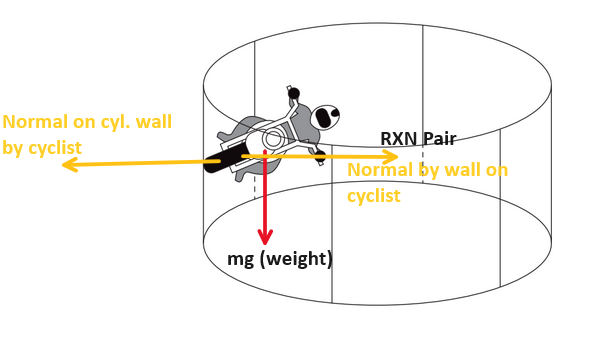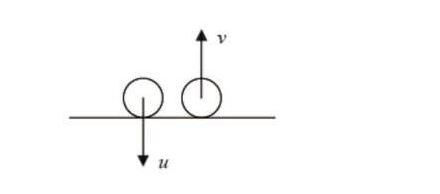Question
A stuntman rides a motorcycle on the inside surface of a cylinder.

Which is the correct free-body diagram showing all the forces acting on the cyclist at that position?

▶️Answer/Explanation
Ans:C

Question
A tennis ball is dropped from rest from a height. It hits the ground and bounces back to a lower height. Air resistance is negligible.
What is correct about the collision of the tennis ball with the ground?
A. Elastic because momentum of the system is conserved
B. Elastic because the kinetic energy of the system is conserved
C. Inelastic because momentum of the system is not conserved
D. Inelastic because the kinetic energy of the system is not conserved
▶️Answer/Explanation
Ans:D
In an elastic collision, both momentum and kinetic energy of the system are conserved. However, in the case of a tennis ball being dropped and bouncing back after hitting the ground, some of the kinetic energy is lost to other forms of energy during the collision, such as heat and sound. Therefore, it is an inelastic collision because the total kinetic energy of the system is not conserved.
Question
A ball attached to a string is made to rotate with constant speed along a horizontal circle. The string is attached to the ceiling and makes an angle of \(\theta^{\circ}\) with the vertical. The tension in the string is \(T\).

What is correct about the horizontal component and vertical component of the net force on the ball?

▶️Answer/Explanation
Ans:D

From FBD we can say option D is correct net force in vertical must be zero as it is rotating in along a horizontal circle.
A ball falls vertically and bounces off the ground. Immediately before impact with the ground the speed of the ball is \(u\). Immediately after leaving the ground the speed is \(v\).

Which of the following expressions is the ratio of
$\frac{\text{kinetic energy lost on collision}}{ \text{kinetic energy immediately before collision}}$ ?
A. \(\frac{v}{u}\)
B. \(1-\frac{v}{u}\)
C. \(\left(\frac{v}{u}\right)^2\)
D. \(1-\left(\frac{v}{u}\right)^2\)
▶️Answer/Explanation
Markscheme
D
When a ball bounces, we can think about the change in kinetic energy. Kinetic energy is related to the speed of the ball.
The loss in kinetic energy during the bounce is the initial kinetic energy (right before the bounce) minus the final kinetic energy (right after the bounce).
\[ \text{Loss} = \frac{1}{2} m u^2 – \frac{1}{2} m v^2 \]
Now, let’s look at the ratio of the loss to the initial kinetic energy:
\[ \frac{\text{Loss}}{\text{Initial}} = \frac{\frac{1}{2} m u^2 – \frac{1}{2} m v^2}{\frac{1}{2} m u^2} \]
Simplify this expression, and you get:
\[ 1 – \frac{v^2}{u^2} \]
So, the answer is:
\[ \boxed{\text{D. } 1 – \left(\frac{v}{u}\right)^2} \]
This expression represents the proportion of kinetic energy lost during the bounce compared to the initial kinetic energy before the bounce.
A tennis ball of mass m moving horizontally with speed u strikes a vertical tennis racket. The ball bounces back with a horizontal speed v.

The magnitude of the change in momentum of the ball is
A. m (u + v).
B. m (u – v).
C. m (v – u).
D. zero.
Answer/Explanation
Markscheme
A
Taking left side positive ,
∆P \(= mu- m (-V)\)
\(= m (v+u)\)